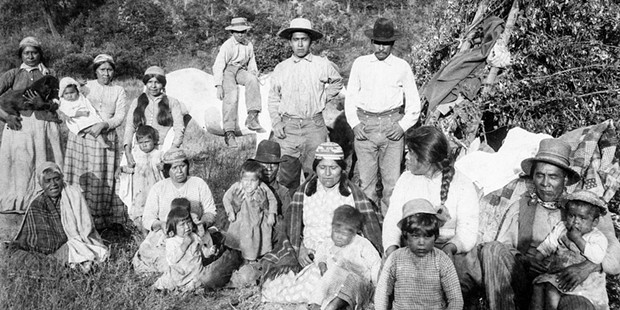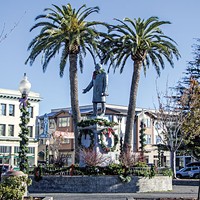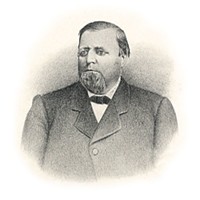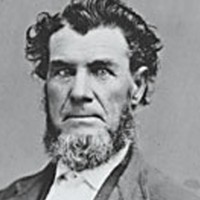An American Genocide
Humboldt County's role in the mass slaughter of California Indians wasn't limited to a massacre, vigilantes or even a militia. It was systemic.
By Jerry Rohde[
{
"name": "Top Stories Video Pair",
"insertPoint": "7",
"component": "17087298",
"parentWrapperClass": "fdn-ads-inline-content-block",
"requiredCountToDisplay": "1"
}
]
On the morning of April 7, 1862, Capt. David B. Akey and a detachment of soldiers from the Second California Cavalry left their camp in the Kneeland-Iaqua area. They were looking for Indians. The ground was covered with four inches of snow, which made tracking easy.
Akey described what happened next. "Found fresh trail of two Indians as reported by scouts," he wrote. "Followed the trail about one mile; came in sight of two Indians, supposed to be spies; ordered the men to fire; both were killed."
That same day, in San Francisco, Brig. Gen. George Wright issued a remarkable order to Akey's commander, Col. Francis J. Lippitt, who was in charge of the army's District of Humboldt. It stated in part: "The Indian difficulties in the Humboldt District have been growing worse and worse for years, and I am determined to settle them now for the last time. Every Indian that you may capture, and who has been engaged in hostilities present or past, shall be hung on the spot. Spare the women and children." (Emphasis added.)
The killing of two Indians based merely on a supposition of an army captain and an army general's order to execute Indian prisoners of war may seem shocking today, but in California in the mid-19th century such actions were typical. They were part of a statewide holocaust, whose victims were the Indian peoples who had lived here for centuries, and whose perpetrators were part of a white population that had been here but a few years. In those days, there was no word to fully describe these actions. But now, a century and a half later, we call it genocide.
This is exactly what UCLA history professor Benjamin Madley has done in his recently published book, An American Genocide: The United States and the California Indian Catastrophe, 1846-1873. Using army records, newspaper accounts and a variety of other sources, Madley meticulously pieced together a record of hundreds of incidents where whites massacred, murdered or otherwise harmed Indians. Sometimes the deeds were done by groups of vigilantes, but often the perpetrators were soldiers in the U.S. Army or members of the California state militia. By the early 1850s such attacks had become so widespread that Madley labels them a "killing machine."
Although some California Indians "did violently resist invasion, theft and exploitation," Madley notes that "this was no regular war." Rather, "whites routinely carried out acts defined as genocidal, most conspicuously by killing thousands of California Indians, often by surrounding and massacring whole villages."
For more than 150 years, one tragic event has dominated the history of Indian-white relations in Humboldt County—the killing of scores of Wiyot Indians in February of 1860 in what is called the Indian Island Massacre. It occurred less than a mile from Eureka, and it was reported in the state and national press. Even the most biased writers, such as Indian Wars of the Northwest author Anthony Jennings Bledsoe, admitted that the act was horrifying and castigated the whites who had conducted it. When the Samoa Bridge was completed across Humboldt Bay in 1971, it offered hundreds of motorists a daily bird's eye view of the massacre site. Indian Island became — and has remained — an emblem of the darkest time in the county's history.
But the emblem is misleading, for it reduced years of death and destruction to a single event. Focusing on this one massacre has allowed us to acknowledge and condemn the actions that a small group of people committed over a short space of time, but it obscures the many other similar incidents that occurred during a period measured not in hours but in decades. By thus diminishing the magnitude of what happened, the emblem of Indian Island has made the intolerable seem merely terrible.
For Madley, and for others like him who work in the field of genocide studies, this is not an acceptable outcome. Atrocities planned and committed by a group of people are seldom isolated events. They are usually part of a series of actions that have some larger destructive goal in mind. In this case, the goal was the extermination of the California Indians, and it was shared by many local citizens and by much of the military. Our knowledge of a single massacre needs to be vastly expanded in order to capture the enormity of the crime. Just as we distinguish between manslaughter and something worse — murder — here we need to distinguish between murder and something worse—genocide.
And this is what Madley, with remarkable thoroughness, has done. Starting with events in 1846 and continuing to 1873, he documents the continual killing of Indians throughout the state. More than that, he shows that these acts were not a series of isolated incidents but became part of a systematic effort to destroy the Indian people.
"Recording the numbers of California Indian people killed is not a mere academic exercise," Madley writes in the book's introduction. "As anyone who has lost a loved one knows, the death of a single person is a profound loss. Recording how many California Indians were killed between 1846 and 1873 is, in part, an attempt to understand the magnitude of the rupture and profound pain caused by their loss: each murder severed personal, familial, and tribal links. Each was a tragedy. When multiplied by thousands during a short period, the impact was nothing less than devastating. In the context of genocide, recording deaths also dignifies the slain and gives a voice to the departed."
"Genocide" is one of the most potent words imaginable. It conjures up images of Nazi concentration camps, of the wholesale killing of entire groups of people based on some horrible mixture of revenge, prejudice and greed. The persons who combine to commit this act are condemned as truly evil. It is not a term to be used lightly and there is a set of standards that allow us to clearly determine if genocide has occurred. These are found in Article II of the United Nations Genocide Convention, a document approved by the United Nations General Assembly in December of 1948.
The article lists five actions that constitute genocide when "committed with the intent to destroy, in whole or part, a national, ethnical, racial or religious group." The actions include not only "killing members of the group," but also "causing serious bodily or mental harm" and forcibly "transferring children of the group to another group."
Throughout his book, Madley documents instances where such genocidal acts were committed. Many of these events occurred in Humboldt County and its neighbor to the north, Klamath County, a now-defunct entity that once extended from School Road in McKinleyville all the way north to the Oregon border.
One of the early events that Madley chronicles took place far from Humboldt Bay but soon affected this area. In early 1850, numerous Indians were massacred in Sonoma and Napa counties by vigilantes that included the brothers Benjamin and Samuel Kelsey. A group of local ranchers intervened to stop the killing, and several of the raiders were arrested by the mayor of Benicia. Eight of the vigilantes were held for trial but were released on bail following the first decision ever made by the California Supreme Court. All eight quickly jumped bail and headed for places far away from the law. Several of the vigilantes, including the Kelseys, soon arrived at Humboldt Bay, where they helped found the town of Union, later to be called Arcata. (For details of this episode, see "The Sonoma Gang" in the Sept. 11, 2008 Journal.)
In January of 1855 came one of the first sustained attacks on local Indians. A dispute over an ox killed by some members of the Karuk tribe led to escalating violence on the part of local miners. Between Oct. 27 and Jan. 23, five volunteer militia companies were raised on the Klamath and Salmon rivers. One militia captain, Frank Buzelle, wrote from Orleans that "it was in contemplation to make a general attack on all the tribes" and that all were "marked down for slaughter." Buzelle, an atypical militia officer, reported that he reached the mouth of the Salmon on Jan. 24 "just in time to save a general massacre" of the Karuks. But the conflict nonetheless escalated. The Indians fought to defend themselves and what was known as the Red Cap War ensued. Soon it was reported that some 70 to 80 Indians had been killed, compared to just eight white men. Finally in late March, intervention by U.S. Army Capt. Henry M. Judah brought the "war" to an end. Judah mustered out the militia units and persuaded the Indians to surrender. But the remaining Indians' salvation came at a price—many of them were sent to the new Klamath Indian Reservation, losing their land and their freedom in the process.
During the next few years the sporadic killing of Indians in the Humboldt area continued. Madley quotes California historian Theodore H. Hittell, who in the late 19th century reported that "in 1856 there were a number of small expeditions by whites against [Nongatl, Sinkyone, Wiyot and other] Indians in the Eel river and Humboldt Bay regions, in each of which, though little or no provocation had been given, from six to 10 Indians were killed ... when volunteers went on the hunt they made it a point to avoid ridicule on their return and were sure to bring back scalps."
Sometimes the attackers were groups of vigilantes that came together in response to a single incident, such as the killing of some cattle in September of 1856 by Indians near Hempfield's Ranch in the mountains southeast of Blue Lake. In this case, several Indians at a nearby village were murdered in blind retaliation for the loss of the cattle. Other vigilante actions lasted longer, including a series of attacks in the upper Mattole Valley. There, in the summer of 1858, whites were found to be "waging a general war against the Indians [killing] some 15 or 20 ... ." A federal agent reported that "a war of extermination has been declared," in the southern Humboldt area, where "some 20 or 30 men are said to have been busily occupied ... in killing."
Similar to the vigilantes, but operating under the guise of government approval, were the state militia units. In October of 1858 some 80 volunteers enlisted in a company commanded by Capt. I. G. Messic. These troops ranged over much of eastern Humboldt County, in the Van Duzen and Mad river drainages and also along Redwood Creek. By the end of March of 1859 Messic's men had reportedly killed between 75 and 100 Indians and taken about 350 prisoners. Not a single militiaman had died, largely because Messic's men did not fight battles; instead they made surprise assaults on peaceful villages. The volunteers were mustered out of service in early April. Less than two weeks later, a grateful state Legislature "knowing that they were financially backed by Congress, voted to pay for this genocidal campaign after the fact," as Madley puts it.
But such funding was not always forthcoming. In February of 1860 residents of the Hydesville area organized a group of vigilantes called the Humboldt Cavalry, which proceeded to ride up to the South Fork Eel and kill some 40 Indians. The group then applied for enlistment as state militiamen. When Gov. John Downey refused their request, members of the Humboldt Cavalry "resolved to kill every peaceable Indian man, woman and child in this part of the country." The result was the Indian Island Massacre and several similar attacks. (For a full account of these massacres, see "Genocide and Extortion" in the Feb. 25, 2010 issue of the Journal.)
One of the persons reporting on the massacres was the commander at Fort Humboldt, Maj. Gabriel I. Raines. Like Cap. Judah and certain other army officers who had preceded him, "emphasized protecting and negotiating with the Indians," according to Madley. But Raines was soon reassigned to Washington Territory, and in early 1861 came orders that countermanded his pacification policy. The commander of the Pacific Department, brevet Brig. Gen. Albert Sidney Johnston, issued instructions for what Madley calls "a new wave of genocidal killing led by the US Army."
Under Johnston's orders in mid-April, three separate army units moved into southern and eastern Humboldt County. One group attacked Indians along the Mad River and Redwood Creek. Another focused on Larabee Creek, in the central part of the county. The Indians there were taken by surprise; they were used to army units trying to capture them, but this time the soldiers came to kill. The third prong of the attack was on the South Fork Eel. Here the bewildered commander, Lt. James P. Martin, tried to make sense of his orders. He stated that "I do not know positively what depredations, if any, have been committed by the Indians killed by this command," and added, "my instructions are to consider all who run on approaching them as hostile and to fire upon them. In every case where any have been killed they ran at the first sight of the [army] men."
In three months' time, the soldiers killed more than 200 Indians. The United States Indian Affairs commissioner, William P. Dole, evaluated the attacks later that year. "This so-called 'Indian war' appears to be a war in which the whites alone are engaged," he reported scathingly. "The Indians are hunted like wild and dangerous beasts of prey; the parents are 'murdered,' and the children 'kidnapped.'"
Despite this condemnation by a federal official, Washington, according to Madley, continued its support of "genocidal actions by paying the killers' salaries after the fact."
So it was that by mid-1861, California Indians faced death from three forces—vigilantes, state militia units, and the regular soldiers of the U.S. Army. Bad as this was, it then became worse. Following the start of the Civil War in April 1861, the Secretary of War asked the governors of the various Union states to create volunteer units that would be brought into the army. In many states the volunteers became part of the forces that were fighting the Confederates. In California, however, the volunteer regiments and companies replaced regular army units that were sent east to fight. In all, almost 16,000 Californians joined up and many of them would participate in a new, more intense round of Indian killing.
At first, the volunteers were moderated by the benign policy of the new commander at Fort Humboldt, Col. Francis J. Lippitt, who issued one set of orders that instructed an officer "not to make war upon the Indians nor to punish them for any murders or depredations hitherto committed, but to bring them in and place them permanently on some reservation where they can be protected ... without bloodshed whenever it is possible."
But, like Maj. Raines before him, Lippitt was soon overruled by a higher authority. In April came General Wright's order to execute male Indian prisoners, which helped open the floodgates for further bloodshed. Within two days Lippitt had reversed himself and repeated Wright's draconian command to his subordinate officers. At least 120 Indians had been killed by June in the subsequent campaign. In August, an attack by a party consisting of both volunteers and vigilantes killed between 24 and 40 Indians on Little River.
While murdering Indians, soldiers also continued to take prisoners. In September, some 833 Indians were removed from Humboldt County and sent by ship to Crescent City, where they were moved to the Smith River Reservation. Before they left, an unspecified number had died, "probably owing to close confinement."
Once at Smith River or other Indian reservations, the inmates faced concentration-camp conditions. According to Madley, "confinement to a federal reservation was a death sentence for many of the state's Indian people, whether they were starved to death, worked to death, shot, hanged, massacred, or died of sickness there." Some Indians managed to escape from the reservations, but they often fared no better than those they left behind. A group of Lassik Indians broke loose and managed to make their way back to their homeland on the Eel River. However, they were captured by vigilantes near Fort Seward and there, according to the Lassik woman Lucy Young, some 40 Lassik males were lined up in a row and shot. The murderers then burnt the bodies.
During this time another genocidal crime occurred—that of "forcibly transferring children of the group to another group." A number of women and children were captured in the Eel River region. The women were removed to Fort Seward, but "the children were all taken south and never heard of again." It is likely that they were sold as slaves, a practice that individual whites had been engaging in for years. The difference now was that volunteers in the U.S. Army were complicit.
The murderous activity of the army and the vigilantes was not enough to satisfy many of the locals. In January 1863 a meeting in Eureka "recommended that 500 volunteers begin hunting Indians." That same month the Klamath County Grand Jury asked for the old standby, state militiamen. Soon the legislative delegation of Humboldt, Del Norte and Klamath counties visited General Wright and asked him to suggest to Gov. Leland Stanford that he call out the militia. Wright asked, but Stanford instead formed 10 new volunteer companies to join the U.S. Army. Six companies that were mustered between May of 1863 and March of 1864 became known as the Mountaineer Battalion. In June of 1863 the battalion's lieutenant colonel, local newspaper editor Stephen G. Whipple, took command of the Humboldt District from Col. Lippitt.
Whipple's troops continued the destruction of the Humboldt County Indians, but apparently at too slow a pace. In February of 1864, Wright replaced Whipple with Henry M. Black, who brought 250 soldiers with him. In addition, two new Mountaineer companies were soon mustered into service, making a total of 16 companies operating in the Humboldt Military District.
Black was clearly trying to play an endgame. He revived the order "that all Indian men taken in battle shall be hung at once" as his troops had killed "perhaps 100 people" or more by June. Black had also collected 500 prisoners at Fort Humboldt.
Then, mercifully, came a change in tactics. In July, California Indian Affairs Superintendent Austin Wiley, the former editor of the Humboldt Times, met with Indians from the Hoopa area, including 75 armed warriors who remained at large. In August, Wiley concluded a treaty with the Hupa Indians and their neighbors that ultimately established the Hoopa Valley Indian Reservation. And finally, the army altered its genocidal policies. That November, Gen. Irwin McDowell issued a resounding order that "Hereafter no officer or soldier will execute or aid in executing any Indian prisoner on any pretext whatever."
With these events, the killing machine on the North Coast was finally dismantled. In the following years there were a few isolated incidents but nothing like the unrelenting attacks of the previous decade. The statewide toll, by the end, was enormous. In all, Madley estimates that a minimum of "some 9,000 to 16,000 California Indians, and probably many more" were killed by U. S. Army troops, California state militiamen and vigilantes. Although "in some instances, U. S. Army officers acted to protect California Indians from violence," Madley believes that army soldiers nonetheless killed at least 1,680 Indian people. He also notes that "neither the U.S. government nor the state of California has acknowledged that the California Indian catastrophe fits the two-part legal definition of genocide set forth by the 1948 UN Genocide Convention."
But, as Madley's evidence proves, what occurred in Humboldt County and elsewhere in the state was indeed "an American genocide."
Jerry Rohde is an ethnogeographer and historian who writes about Humboldt County. His most recent book, Both Sides of the Bluff, is a history of the lower Eel and Table Bluff.
Benjamin Madley
Benjamin Madley spent much of his childhood in Karuk Country on the Klamath River. As Madley puts it, "My father worked with Karuk Indian people there so, at an early age, I became aware of ongoing conflicts between Native Americans and newcomers." In high school in Los Angeles, Madley found that the school's mascot wore a Great Plains war bonnet, which he knew was not the traditional regalia of California Indian people. He also learned that one of his classrooms was built on the site of a Tongva Indian village. These experiences caused Madley to wonder, "Where are all of the Indian people?"
Madley received his B.A. from Yale University, focusing on genocide in Australia. His M.A. was completed at Oxford University and dealt with colonial violence in southwest Africa. He returned to Yale for his Ph.D. Deciding to focus on his home state, Madley wrote about the California Indian catastrophe. His dissertation was gradually transformed into An American Genocide. It took him "the better part of a decade" to complete the work.
Madley is currently an assistant professor of history at the University of California, Los Angeles. He teaches courses about Native America, the United States and genocide in world history.
Meet the Author
On Nov. 2 and 3, Ben Madley will give three presentations at Humboldt State University. They are all free and open to the public.
Wednesday, Nov. 2
11 a.m. to 12:30 p.m. — Lecture: Tolowa Genocide (Native American Forum)
5 to 6:50 p.m. — Lecture: The Question of Genocide in American History (Native American Forum)
Thursday, Nov. 3
11:00 a.m. to 1 p.m. — Book Talk with Q&A: An American Genocide: The United States and the California Indian Catastrophe, 1846-1873 (HSU Library Authors Hall)
For a map of the HSU campus, go to: www.humboldt.edu/sites/default/files/campusmap.pdf
Comments (9)
Showing 1-9 of 9
more from the author
-
This Land Is Their Land
- Sep 1, 2022
-
The 200th Victim
Humboldt County's response to the 1918-1919 and what it teaches us a century later
- Apr 2, 2020
-
The Women Behind the Trees
Laura and James Wasserman's Who Saved the Redwoods? The Unsung Heroines of the 1920s Who Fought for Our Redwood Forests
- Jun 6, 2019
- More »
Latest in News
Readers also liked…
-
Through Mark Larson's Lens
A local photographer's favorite images of 2022 in Humboldt
- Jan 5, 2023
-
'To Celebrate Our Sovereignty'
Yurok Tribe to host gathering honoring 'ultimate river warrior' on the anniversary of the U.S. Supreme Court ruling that changed everything
- Jun 8, 2023






































